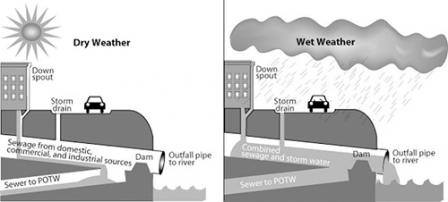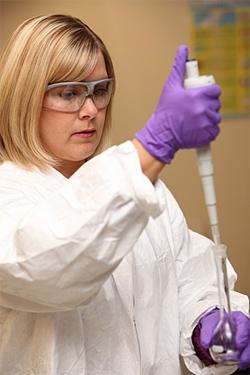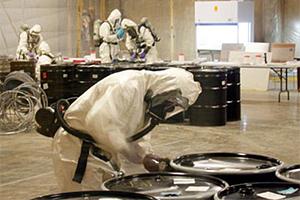EPA Science Matters Newsletter: Volume 3, Number 1
Published April / May 2012
About this Issue
- About this Issue

Cleaner water and healthier communities. Smoke-free offices, schools, and public spaces. Even longer life spans. These are just some of the impacts of EPA science.
Scientific achievements often unfold without fanfare, accruing over time through a carefully prescribed process of repeated observations, data collection, and analysis that may span generations of testing and retesting. More often than not, the impacts of that work fly under the radar.
Never the less, they do occur. Whether conducted in response to high-profile national emergencies such as the terrorists attacks of 9/11 and the BP oil spill, or in response to long-term environmental and related human health challenges such as air and water pollution and potentially harmful contaminants in our communities, EPA researchers and their partners have been working for more than 40 years to provide the science and technology needed to protect human health and the environment.
This issue of EPA's Science Matters highlights stories that exemplify some of the important impacts of that work. On EPA's landmark assessment on the dangers of secondhand smoke, Matthew L. Myers, the President of the Campaign for Tobacco Free Kids remarks: "The impact has been healthier kids, healthier parents, healthier workers, and an awareness that the science is clear: if you smoke around kids and other non-smokers, you threaten and endanger their health."
Myers is but one of the many people who help tell the story of the impact of EPA research outlined in this issue. Featured are stories about EPA's integrated science assessments, "green" infrastructure, community support for achieving cleaner air, enhancing emergency response capabilities in the event of a terrorist attack using anthrax, and more.
EPA science has had real and positive impact over the past 40 years, and continues to do so today. The collective effort has already resulted in cleaner air and water, healthier communities, and longer life expectancies for all Americans. Now that's impact.
GEMS: Great Environmental Moments in Science
- EPA Integrated Science Assessments: Helping Fight Air Pollution
EPA's Integrated Science Assessments deliver the science to support the Clean Air Act, one of the most beneficial federal programs in the nation.

The average American breathes more than 11,000 liters of air—enough to fill a tanker truck—every day. Understanding this, it's easy to see why air pollution is of such concern. Forty years ago, air pollution was so prevalent in some cities that you may have complained of burning eyes from ozone pollution, or the air was so visibly polluted that you couldn't see across the city.
Back then, Americans were exposed daily to potentially dangerous amounts of ground-level ozone and other pollutants, symptoms of which often included airway irritation and increased susceptibility to illnesses such as asthma and bronchitis.
Today, large segments of the population are breathing cleaner, healthier air—a direct result of the Clean Air Act and the scientific framework put in place to guide actions taken to protect human health, the Act's primary goal. That framework is built around EPA's National Ambient Air Quality Standards (NAAQS) and the Integrated Science Assessments (ISAs) that deliver the science supporting those standards.
The landmark Clean Air Act (CAA), enacted by Congress in 1970, was one of the federal Government's first efforts at regulating air quality in order to protect human health and the environment. Congress created the EPA soon afterward, in part to implement the new law.
Last amended in 1990, the CAA requires EPA to develop NAAQS for six criteria pollutants: carbon monoxide, lead, nitrogen dioxide, ozone, particulate matter, and sulfur dioxide. The standards set permissible limits for each pollutant that must be met in order to protect public health—including the health of sensitive groups such as asthmatics, children, and aging adults—as well as public welfare, including protection against damage to animals, crops, and buildings.
During the first 20 years of the Clean Air Act, health benefits increased steadily from 1970 to 1990. In the year 1990, clean air programs prevented: 205,000 premature deaths; 672,000 cases of chronic bronchitis; 21,000 cases of heart disease; 843,000 asthma attacks; 189,000 cardiovascular hospitalizations; 10.4 million lost I.Q. points in children from lead reductions; and 18 million child respiratory illnesses.
It is because of these health improvements that the ISAs for each criteria pollutant and the NAAQS they support are essential. Children, aging adults, and people with certain diseases are particularly at risk for pulmonary, cardiac, vascular, and neurological impairments as a result of long-term air pollution exposure.
As required by the CAA, EPA conducts periodic reviews of the six criteria air pollutants and develops ISAs that summarize the science related to the health and ecological effects caused by the pollutants. To achieve this, EPA scientists conduct a comprehensive review of the policy-relevant scientific literature published since the last review, ensuring that each ISA is based on the latest scientific information.
After the best available science has been evaluated and synthesized, each ISA is vetted through a rigorous peer review process, including evaluation by the independent Clean Air Scientific Advisory Committee (CASAC). Each assessment is also made available for a public comment period. The end result is rigorous, science-based assessments to guide the development of NAAQS for each criteria pollutant.
"We at the American Lung Association rely on the EPA's Integrated Science Assessments for the most thorough review of the available research on the criteria pollutants," says Janice Nolen, Assistant Vice President of National Policy and Advocacy at the American Lung Association Exit. Ellen Porter of the National Park Services' Air Resources Division adds, "ISA data on human and ecosystem impacts are used to establish benchmarks to rate air quality conditions in parks as either good, moderate, or of significant concern. These condition assessments are used to help identify national parks most at risk from air pollution."
Thanks to the ISAs and NAAQS, the Clean Air Act has made significant and far-reaching impacts on the health and well being of the American public, including longer life expectancies Exit, healthier communities, and more sustainable ecosystems.
Learn More
- Clearing the Air
The Impact of EPA's Landmark Health Assessment on "Passive Smoking"

A recent segment on the daytime talk show "Ellen" featured a comical look back at old advertisements. One example to flash across the television revealed a confident looking doctor leaning back in his chair with a freshly lit cigarette in his hand. The studio audience roared with laughter as the host read aloud the screaming headline below the image: "According to a Recent Nationwide Survey: More Doctors Smoke Camels than Any Other Cigarette."
A quick internet search of vintage smoking ads reveals a host of such claims. In addition to smiling babies, Ronald Reagan, and Santa Claus, science and statistics were common themes enlisted to help consumers choose one brand of smokes over another.
Of course, it wasn't until real science began to investigate the health effects of smoking that the smartest choice—not to smoke at all—was revealed.
This year marks the 20th anniversary of a landmark EPA health assessment, Respiratory Health Effects of Passive Smoking: Lung Cancer and Other Disorders, that put much of that science into perspective. The assessment concluded that tobacco smoke not only presented risks to the health of smokers but also to those around them: "Based on the weight of available scientific evidence, the U.S. Environmental Protection Agency (EPA) has concluded that widespread exposure to environmental tobacco smoke (ETS) in the United States presents a serious and substantial public health impact."
The science behind the assessment provided the basis and support to health officials and others as they moved to protect people from tobacco smoke in public places. The impacts have been far-reaching, leading to healthier air, particularly indoors, for millions of people.
"EPA's study was a major catalyst for taking action to protect everyone, especially kids, from tobacco smoke. The impact has been healthier kids, healthier parents, healthier workers, and an awareness that the science is clear: if you smoke around kids and other non-smokers, you threaten and endanger their health," says Matthew L. Myers, President of the Campaign for Tobacco Free Kids.
To develop the health assessment, EPA critically reviewed a wealth of existing data from previous studies exploring the potential health effects of what is called "environmental tobacco smoke," or the secondhand smoke that nonsmokers were exposed to by sharing space with those who smoked.
The bulk of that work began to come to light in 1986, when the National Research Council (NRC) and the Surgeon General of the U.S. Public Health Service released independent studies on the health effects of exposure to secondhand smoke. Both reports concluded that exposure to secondhand smoke can cause lung cancer in adult nonsmokers and can lead to increased frequency of respiratory problems, including infections and reduced lung function.
The reports sparked interest by EPA officials, including those looking at studies to better understand questions about air pollution, particularly indoors. Because people spend some 90 percent of their time indoors, exposure to air pollutants inside buildings is significantly higher than it is outdoors. Agency scientists and engineers work to advance the understanding of indoor air quality and to find ways to reduce people's exposure to air pollutants in offices, homes, schools, and other places where people work and play. EPA decided to conduct its own health assessment on secondhand smoke largely because of broad concerns about indoor air quality.
A wealth of additional studies by different independent organizations followed the release of the reports by NRC and the Surgeon General, more than doubling the size of the database EPA researchers were able to consider when they conducted their own health assessment. For that work, Agency scientists critically reviewed the existing database on the respiratory health effects of passive smoking (e.g. inhaling secondhand smoke) to develop a hazard assessment and make quantitative estimates of the public health impacts for lung cancer and various other respiratory diseases.
EPA researchers based their conclusions on an analysis of all the available data at the time, including more than 30 human epidemiological studies looking specifically at passive smoking as well as information on active or direct smoking. In addition, they considered animal data, biological measurements of human uptake of tobacco smoke components, and other available data.
In the end, the assessment concluded that secondhand smoke is a human carcinogen, responsible for 3,000 lung cancer deaths annually in the U.S. The assessment also concluded that infants and young children were especially sensitive to secondhand smoke exposure. Secondhand smoke exposure to infants and young children led to increased risk of respiratory infections such as bronchitis and pneumonia, lower lung function, and additional episodes and increased severity of symptoms in children with asthma.
The EPA study provided the science needed for Agency officials and others across the nation to conclude that secondhand smoke is a preventable health risk.
Even after 20 years, the impact of this work can be seen, and felt, every time a child or an adult is protected from secondhand tobacco smoke. Thousands of lives have been saved, millions of children are healthier, and people across the country, and even in other countries, enjoy smoke-free workplaces and homes.
"The impact of EPA's landmark study can't be underestimated. It provided the science that sparked a revolution in how people view the hazards of secondhand smoke, which has led to smoke-free policies across this country and around the world. Millions of people are protected and ultimately millions of lives will be saved," says Albert A. Rizzo MD, Chair of the American Lung Association Board of Directors.
Learn More
- EPA Smoke-free Homes
- EPA Indoor Air Research
- Download a copy of Respiratory Health Effects of Passive Smoking: Lung Cancer and Other Disorders (PDF) (525 pp, 3.9MB, About PDF)
- Tapping Green Infrastructure to Curb Sewer Overflows
Utilizing EPA research and guidance, Cleveland and Cincinnati plan to reduce sewage overflows with the help of sustainable, green practices.
 Illustration: Combined sewer overflows during dry and wet weather (note: "POTW" means "publicly owned treatment works").
Illustration: Combined sewer overflows during dry and wet weather (note: "POTW" means "publicly owned treatment works").Imagine running your shower for three thousand years or filling a swimming pool twice the size of Massachusetts. This is the rough equivalent of five billion gallons of water. The sewers of Cleveland, OH dump nearly five billion gallons of untreated sewage into Lake Erie every year. Even more impressive: the sewers of another Ohio city, Cincinnati, discharge 14 billion gallons of wastewater annually into the urban stream Mill Creek.
Like many cities across the country, Cleveland and Cincinnati suffer from aging wastewater systems that cannot properly handle the large amount of stormwater runoff that occurs during severe downpours. These cities have what is called a combined sewer system where sewage and stormwater merge into one series of pipes.
During heavy rainstorms, so much water runs off of common urban surfaces such as pavement and roofs that the system overflows. Combined sewer overflows (CSOs) discharge raw sewage and untreated runoff straight into nearby lakes and rivers, polluting valuable water resources and threatening public health and the environment.
Both Cleveland and Cincinnati have recently negotiated federal consent decrees (legally binding agreements between city, state, and federal agencies) that set CSO pollution reduction goals. The goals are ambitious, but both cities are up for the challenge, formulating plans for new installations and upgrades to existing sewer systems.
With support from EPA, these cities also plan to implement more environmentally-friendly and sustainable stormwater management projects, commonly referred to as green infrastructure.
"In the context of stormwater management, green infrastructure represents a set of practices that can rely on plants and soils to infiltrate, store, and transpire rainfall and excess runoff, or practices that catch rain before it turns into runoff," explains Dr. Bill Shuster, a research hydrologist at EPA.
Examples of green infrastructure include cisterns, green roofs, permeable pavement, wetland-like retention basins, and rain gardens. The goal of green infrastructure is to retain or redirect excess water runoff into the ground where plants and soil will naturally detain and filter the water—and keep it out of the sewers.
Following EPA's guidance and research, Cincinnati and Cleveland are on the leading edge of green infrastructure implementation.
Cleveland Turns Vacancies into Economic, Social, Environmental Assets
Based on technical guidance from EPA experts, part of Cleveland's consent decree Exitcalls for an innovative green infrastructure pilot program estimated to remove 44 million gallons of stormwater from the Northeast Ohio Regional Sewer District's (NEORSD's) combined sewer system. This green infrastructure program is intended not only to reduce stormwater runoff, but also to turn urban eyesores into community assets.
 Before and after: Cleveland vacant lot before and after extensive post-demolition debris removal, soil management, and plantings. The once-vacant lot is now an attractive and functional part of the neighborhood.
Before and after: Cleveland vacant lot before and after extensive post-demolition debris removal, soil management, and plantings. The once-vacant lot is now an attractive and functional part of the neighborhood.
Before and after: Cleveland vacant lot before and after extensive post-demolition debris removal, soil management, and plantings. The once-vacant lot is now an attractive and functional part of the neighborhood.
"Back in June of 2009 I was in a meeting with the sewer district and other departments within Cleveland," recalls Shuster, who is technical advisor to the federal consent decree enforcement team for Cleveland. "It occurred to me that we have this surfeit of vacant land, and that this land could be used to sop up the excess stormwater runoff volume that otherwise goes into these combined systems and causes overflows."
The transformation of urban vacant lots into park-like gardens that catch stormwater runoff would not only help remedy the CSO problem, but also improve the social and economic fabric of neighborhoods historically lacking green space.
Shuster, along with regional EPA employees Brooke Furio and Bob Newport, became known as "The Green Team." Working closely with NEORSD, the Green Team used their research and knowledge to help formulate a plan for turning vacant land into green infrastructure systems.
"We were able to come in and put together what we know about vacant land, what we know about stormwater and wastewater, what we know about enforcement, and what we know about the cities that have to mediate and handle these enforcement orders and put together this project," explains Shuster.
In theory, many vacant lots, especially those in low income residential areas, will help to revitalize their neighborhoods once concrete and debris are removed and ponds, gardens, or other green systems are built in their place. This first-of-its-kind green project will also further EPA's work to advance environmental justice.
"We believe that it's a good way of comprehensively addressing social equity, economic stabilization, and environmental quality simultaneously," says Shuster. "I think our work has shown that proactively getting out there and making a national demonstration of this work in Cleveland, that hey, we can do this, we can work together, we can share risk, we can collaborate and adaptively manage towards optimal sustainable solutions. This is good stuff as far as environmental management is concerned."
Green Demos Foster Research in Cincinnati
The current draft of Cincinnati's consent decree Exitcalls for a 2 billion gallon reduction of CSO discharge by 2018. That's roughly the equivalent to 570 million toilet flushes.
Like Cleveland, Cincinnati's consent decree is destined to have a green infrastructure component.
Throughout the city, EPA scientists monitor green infrastructure demonstration projects to further increase understanding of how these systems work, and especially how reliable and effective they are for reducing CSO.
 Soaking it in: "It's like a mini research facility," remarks Alfaqih of the newly installed rain gardens at St. Francis Court Apartments Exitin Cincinnati. Once the site of unused parking lots, the demonstration rain gardens host specialized monitoring and measuring equipment from EPA and the US Geological Survey.
Soaking it in: "It's like a mini research facility," remarks Alfaqih of the newly installed rain gardens at St. Francis Court Apartments Exitin Cincinnati. Once the site of unused parking lots, the demonstration rain gardens host specialized monitoring and measuring equipment from EPA and the US Geological Survey.
Soaking it in: "It's like a mini research facility," remarks Alfaqih of the newly installed rain gardens at St. Francis Court Apartments Exitin Cincinnati. Once the site of unused parking lots, the demonstration rain gardens host specialized monitoring and measuring equipment from EPA and the US Geological Survey.
Along with similar monitoring efforts at Cincinnati State Technical and Community College, EPA installed sensors beneath porous pavement—pavement designed to soak in rainwater instead of diverting it to sewer drains. Elsewhere, EPA scientists are doing collaborative research with the University of Cincinnati to study rain gardens and porous pavement in terms of water infiltration and the effectiveness of these green systems.
"The science community needs this [research]," says Laith Alfaqih, of The Metropolitan Sewer District of Greater Cincinnati (MSD). "Green systems are in their infancy. How they work, the maintenance, the design of it, all these things are new, but with the help of the US EPA, the research, the implementation of these systems, and showcasing how they work…it's very important and helps a lot for the public and the science community."
EPA has partnered with the Cincinnati MSD and other local groups to study these demonstration sites, called "early success" projects.
This work in Ohio exemplifies how EPA and other organizations have come together to study and support green infrastructure as part of a successful wastewater management program.
Learn More
- New Testing Methods for Arsenic and Lead in Soil
EPA's innovative soil-testing methods could save millions in cleanup costs at Superfund sites across the nation.
 Karen Bradham, Ph.D., researching bioavailability methods.
Karen Bradham, Ph.D., researching bioavailability methods.Cleaning up arsenic and lead at Superfund sites can be an expensive proposition. Currently, if the levels of contaminants are high, the top layer of soil is removed and transported to a hazardous materials landfill for careful treatment to isolate and remove the toxic metals. The price tag for such remediation activities can reach into the millions of dollars per acre.
Developing rapid, reliable, and inexpensive tools for guiding remediation activities that effectively protect human health could have a big impact on the way Superfund and other contaminated sites are managed. When every acre spared from soil removal and treatment means a million less dollars spent, the savings add up fast.
EPA scientist Karen Bradham, Ph.D., and her research partners are working on just those kinds of tools. She and her collaborators are evaluating new and inexpensive methods for assessing arsenic levels as a means to improve human exposure estimates for soil arsenic and lead.
"Not all toxic metals present in soil are in a form that can harm humans or animals," Bradham explains. "Certain forms of arsenic and lead are not fully available or absorbed by the human body."
The amount that is absorbed is referred to as "bioavailable," meaning it is in a form that can enter the bloodstream and affect human health.
Bradham, along with EPA scientists Drs. David Thomas, Kirk Scheckel, and Mike Hughes are focusing their efforts on new methods of assessing bioavailability of arsenic and lead in contaminated soils.
One of the new methods they developed uses laboratory analyses that mimic the way the human digestive system absorbs arsenic to illuminate the amount of bioavailable arsenic in a given sample of contaminated soil.
Preliminary results have been encouraging. When researchers evaluated arsenic-contaminated soil samples from a Superfund site using the newly developed bioavailability methods, they found that only about half the arsenic was bioavailable. In this example, approximately 90 acres of soil would need to be removed, as opposed to the 117 acres that would have been slated for removal using cruder, more traditional tests. Those more traditional tests are based on measurements of total arsenic levels instead of that which is truly problematic for human exposure.
The potential cost savings of the above example: $9 million.
Elizabeth Southerland, Ph.D., former director of the Assessment and Remediation Division in EPA's Office of Superfund Remediation and Technology Innovation, underscored the importance of this work. "The use of site-specific bioavailability information will lead to more accurate risk assessments and customized cleanup levels," she said.
With the new methods, EPA can better evaluate human exposure to toxic soil contaminants at a greatly reduced cost. Further, when a new chemical extraction lab method that's under development is complete, researchers will be able to determine the bioavailability of contaminants without the use of animal studies, greatly reducing testing costs as well.
Roseanne Lorenzana, D.V.M., Ph.D., a scientist in EPA's Pacific Northwest regional office, notes that results from this bioavailability research have already provided information and protocols for assessing large-area contaminations sites. "This research really shows the impact of EPA science on improving environmental decision-making," Lorenzana said.
Learn More
- Cleaning Up the Nation's Hazardous Waste Sites
- EPA Superfund and Technology Liaison Program
- Related Journal Article: Relative Bioavailability and Bioaccessibility and Speciation of Arsenic in Contaminated Soil. [Bradham KD, Scheckel KG, Nelson CM, Seales PE, Lee GE, et al. Environ Health Perspect 119(11): doi:10.1289/ehp.1003352]
- The BP Oil Spill: Responsive Science Supports Emergency Response
EPA scientists provided key support for the federal response to the Deepwater Horizon oil spill.

In April 2010, the offshore mobile drilling unit Deepwater Horizon in the Gulf of Mexico caught fire and collapsed, killing 11 crew members and injuring 17 others. As the platform sank to the ocean floor, the untapped well began to spew millions of gallons of crude oil directly into the Gulf.
Within days, it became clear that a massive response was needed to meet the challenges brought on by the unfolding crisis.
President Barack Obama declared "my administration will continue to use every single available resource Exitat our disposal" to address the incident and help the Gulf and local communities facing what would turn out to be the worst oil spill in U.S. history.
The expertise of EPA scientists was among the first of those federal resources to join the effort. The EPA provided full support to the U.S. Coast Guard, the lead for coordinating response, containment, and remediation activities.
Cleanup and mitigation activities were immediately aimed at minimizing known threats to coastal wetlands, wildlife, fisheries, and other environmental resources. Such activities included booming and skimming operations, burning surface oil, and applying dispersants to break up oil, both on the surface and in the deep waters where the oil was flowing.
Dispersants have properties that break down oil, helping to prevent thick, sticky crude from fouling beaches, coating seabirds and other aquatic wildlife, or reaching ecologically sensitive coastal wetlands. Breaking the oil down into smaller droplets also promotes natural biodegradation by tiny, oil-consuming marine microbes.
But the use of dispersants in the Gulf garnered considerable public debate. Concerns primarily centered around unknowns about the toxicity of dispersants for people and aquatic organisms, especially considering the massive quantities that were called for in the Gulf of Mexico.
In the midst of the ongoing Gulf crisis, EPA scientists were called on to provide key scientific information to help inform decisions about the use of dispersants.
EPA scientists conducted a series of tests on eight commercial dispersants Search EPA Archive, including Corexit 9500, BP's dispersant of choice for cleanup operations.
The first phase of EPA's testing focused on assessing the acute toxicity of dispersants alone (not mixed with oil). Tests were conducted on larval stages of two aquatic species representative of organisms found in the Gulf of Mexico: mysid shrimp (Americamysis bahia) and inland silverside fish (Menidia beryllina).
Additionally, more than 80 in vitro tests from EPA's computational toxicology and endocrine disruptor research programs were used to rapidly screen the dispersants for endocrine activity and cytotoxicity (cell death). This work was conducted under the Agency's collaborative ToxCast program, which taps innovative technologies—including automated, high-throughput screen techniques—to conduct fast, efficient assay and screening tests.
Results from the first phase of testing, released June 30, 2010, indicated that all eight dispersants had roughly the same toxicity, and all fell into the "practically non-toxic" or "slightly toxic" category. Scientists found that none of the eight dispersants displayed endocrine-disrupting activity of "biological significance."
During a second phase of testing, researchers assessed the acute toxicity of multiple concentrations of Louisiana Sweet Crude (LSC) oil alone and in combination with each of the eight dispersants. Results, released on August 2, 2010, indicated that the toxicities of the eight dispersants mixed with oil were roughly similar to one another. Of particular interest to clean up operations, was the conclusion that dispersant-oil mixtures were generally no more toxic to the aquatic test species than oil alone.
The entire process from the initial request to test dispersants to the full report on the dispersants' toxicity took six weeks. This meant that ongoing decisions and activities in the Gulf could be based on science and robust toxicity testing.
Making decisions during a crisis is always a challenge, but EPA's research provided response operations with the scientific information needed to make tough calls about the use of dispersants.
Learn More
- Advancing the Science and Engineering of Decontamination
Using innovative science and engineering, EPA's research is improving the response to anthrax incidents.

In late February 2012, comedians Jon Stewart and Stephen Colbert were part of a news story that was decidedly not funny. Both of them, along with a number of other media outlets and several members of the U.S. Congress, received threatening mail containing white powder. "The FBI is aware of this situation and is responding accordingly," said FBI spokesman Chris Allen at the time. Thankfully, the substance inside the menacing letters turned out to be harmless. The incident, however, serves as a pointed reminder of the need for constant vigilance in the fight against terrorism.
In the ten years since the tragic events of September 11, 2001 and the subsequent mailing of a series of anthrax-laced letters (the "Amerithrax" incident) to two U.S. Senators and several media outlets, causing the deaths of several postal workers, the homeland security and emergency response communities have worked tirelessly to prevent further incidents and to be better prepared in the event one does occur. EPA's Homeland Security Research Program has been an integral part of that effort.
EPA is the lead federal agency responsible for remediating indoor and outdoor environments following incidents involving biological contamination. Established in 2002, EPA's Homeland Security Research Program (HSRP) provides the research that supports operations for Agency and partner activities in that area. Thanks to these activities, if the threatening letters recently sent had contained anthrax, the nation would have been better prepared than it was ten years ago.
One lesson learned from the Amerithrax incident was that the nation lacked the collective capacity for analyzing environmental anthrax samples in the event of a terrorist incident. At that time, there were no standardized methods for sampling, detecting, and characterizing biological agents in environmental samples, meaning that inter-laboratory data could not be compared during and after a large-scale event.
To address those shortcomings, EPA helped establish and now manages the Environmental Response Laboratory Network (ERLN), a collection of federal, state, and commercial laboratories that focus on responding quickly and consistently to potentially catastrophic events such as terrorist incidents involving chemical, biological, or radiological incidents, or natural disasters.
To support ERLN, EPA researchers released Selected Analytical Methods for Environmental Remediation and Recovery Following Homeland Security Events, a publication outlining selected methods for measuring specific contaminants that might be associated with a terrorist attack. Included are methods for evaluating the nature and extent of contamination and for assessing the efficacy of decontaminants.
The publication presents an innovative test method that EPA researchers developed—a Rapid Viability Polymerase Chain Reaction protocol—that speeds up analysis and eliminates waste, compared to traditional culture methods. Labs using the new method are able to confirm anthrax presence and viability from a number of samples, a critical need for a large-scale contamination event.
Another area where the impacts of EPA research are paying dividends is during cleanup activities, particularly remediation and waste management. Two examples of this are real-world biological incidents where musicians were exposed to anthrax spores from the animal hides used to make drums. Working with EPA Regional response personnel, HSRP scientists and engineers identified the most effective remediation methods to remove anthrax from the musicians' homes and work areas.On a parallel track, researchers have been assisting EPA's Office of Chemical Safety and Pollution Prevention by verifying what decontaminants registered by manufacturers under the Federal Insecticide, Fungicide and Rodenticide Act are most effective.
Advances in science and technology research culminated in the Bio-response Operational Testing and Evaluation (BOTE) program, co-led by EPA and the Department of Homeland Security. BOTE was conducted in 2011 as a two-phase field demonstration project designed to collect scientific and technical information on various decontamination techniques for anthrax. This information will be used to continue refining approaches and products that can be used to cost-effectively decontaminate buildings and outdoor areas.
In Phase 1 of BOTE, EPA researchers evaluated three decontamination methods: fumigation with vaporized hydrogen peroxide, fumigation with chlorine dioxide, and a treatment process including the use of pH-adjusted bleach spraying. In Phase 2, a response and remediation exercise was conducted at a facility contaminated with anthracis simulants. Phase 2 remediation decisions included information from Phase 1 with respect to decontamination efficacy, waste management, and overall cost. (It also included results from the laboratory testing of other decontaminants such as methyl bromide, which was ultimately used to fumigate the facility.) Results of the BOTE field studies will be published later this year.
"Through applied research and technical support programs such as these, HSRP is increasing the readiness and capacity of the nation's laboratories and advancing the analysis of decontamination technologies. In the BOTE project, EPA scientists are providing information that will have real impact should we need to respond to any future anthrax incidents. Although a best case scenario would be to never fully realize that impact, it's great to know we are better prepared," said Erica Canzler, the Director of EPA's National Decontamination Team in the Agency's Office of Emergency Management.
Editor's Note: EPA's Homeland Security Research Program was featured in the September, 2011 issue of "Science Matters." Click here to learn more.
Learn More
- Power Generation and the Environment
EPA's New Haven accountability project helps community strike a balance.

It's not often that power companies, residents, and environmental groups can all agree to build new power turbines and an exhaust stack. With the support of EPA research and data, the City of New Haven, Connecticut and community groups worked with the power company Public Service Enterprise Group (PSEG) Exit to develop a plan to offset the emissions from PSEG's new turbines and exhaust stack.
Natural gas-powered turbines, called peaker plants, are meant to help meet energy demands during peak hours. However, building gas-powered peaker plants also means an increase in air pollution—particularly in nitrogen oxides (NOx), sulfur oxides (SOx), and particulate matter (PM), which can damage the heart and lungs.
EPA researchers developed an air model of New Haven that estimated air pollution out to 2030 and presented it to city officials and residents. The model showed several air pollution "hotspots," one of which was the location of the proposed peaker plants.
Based on this information, the City of New Haven opposed the plan "unless [PSEG] found a way to ensure that [the peaker plants] would result in no net emissions," says Robert Smuts, Chief Administrative Officer for the city. This meant that the cumulative emissions (total amount of pollution) and acute emissions (emissions at specific times such as peak hours) should be no higher than current levels throughout the city.
To meet the city's wish for no new net emissions, PSEG made modifications to their existing plants to help offset the emissions of NOx and SOx from the new turbines and stack. While this action effectively controlled NOx and SOx emissions, the modifications did not offset PM emissions.
Using EPA air quality and exposure models, local environmental groups, the Environmental Justice Network, neighborhoods, city officials, and PSEG formed a stakeholder group to collaboratively find alternative methods to reduce PM emissions. PSEG provided $500,000 to support the effort.
The stakeholder group used EPA's air quality model AERMOD, which predicts pollutant concentrations from stationary and mobile sources, and the Agency's Community Multi-scale Air Quality (CMAQ) Modeling System, which predicts regional background concentrations in the study area.
 Image from EPA's CMAQ program.
Image from EPA's CMAQ program.The group also used exposure models, including EPA's Stochastic Human Exposure and Dose Simulation model for Air Toxics (SHEDS-Air Toxics), to estimate the human exposure from breathing in the pollutant.
To meet the necessary reductions in PM emissions, the stakeholders group formed a three-part plan:
- Retrofit diesel garbage trucks in the area to reduce PM exposures in neighborhoods at the ground level where humans have the most contact with the pollutant.
- Add filters to equipment in the port such as cranes and bulldozers to offset PM from the ships coming into the city.
- Install power outlets for boats docked in the port as an alternative to using their diesel generators.
According to New Haven's Robert Smuts, all groups supported the three-part plan, and the collaboration and cooperation across groups allowed New Haven and PSEG to "overcome the negative thoughts about putting in new turbines and exhaust stack." Smuts stressed that an agreement was possible due to the company's efforts, the credibility of the EPA data, and trustworthiness of the city officials.
The interactions between PSEG, the city of New Haven, and community groups provide an ideal example of effective collaboration and negotiating that resulted in new construction to meet energy demands with no net increases in emissions. New Haven's efforts to work with the power company now serve as best practice examples for other cities in Connecticut and across the nation.
Learn More
